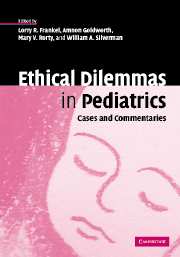Book contents
- Frontmatter
- Contents
- List of contributors
- Preface
- Introduction
- Part I Therapeutic misalliances
- 1.1 Unconventional medicine in the pediatric intensive care unit
- 1.2 Role responsibility in pediatrics: appeasing or transforming parental demands?
- 1.3 Topical discussion
- 2.1 The extremely premature infant at the crossroads
- 2.2 The extremely premature infant at the crossroads: ethical and legal considerations
- 2.3 Topical discussion
- 3.1 Munchausen syndrome by proxy
- 3.2 Some conceptual and ethical issues in Munchausen syndrome by proxy
- 3.3 Topical discussion
- Part II Medical futility
- Part III Life by any means
- Part IV Institutional impediments to ethical action
- References
- Index
- References
3.3 - Topical discussion
Published online by Cambridge University Press: 18 August 2009
- Frontmatter
- Contents
- List of contributors
- Preface
- Introduction
- Part I Therapeutic misalliances
- 1.1 Unconventional medicine in the pediatric intensive care unit
- 1.2 Role responsibility in pediatrics: appeasing or transforming parental demands?
- 1.3 Topical discussion
- 2.1 The extremely premature infant at the crossroads
- 2.2 The extremely premature infant at the crossroads: ethical and legal considerations
- 2.3 Topical discussion
- 3.1 Munchausen syndrome by proxy
- 3.2 Some conceptual and ethical issues in Munchausen syndrome by proxy
- 3.3 Topical discussion
- Part II Medical futility
- Part III Life by any means
- Part IV Institutional impediments to ethical action
- References
- Index
- References
Summary
Munchausen syndrome by proxy (MSBP)
Munchausen syndrome, poetically named in 1951 after German fables of the fictitious Baron Munchausen, denotes factitious or imaginary illnesses intentionally feigned in order to gain access to medical care. The label of Munchausen syndrome by proxy entered the literature in 1977. Confusion about whether it is a diagnosis of the perpetrator or the victim has been recently resolved by distinguishing between “pediatric condition falsification” (PCF), a diagnosis of the victim, some cases of which have other causes, and “factitious disorder by proxy” (FDP), a diagnostic category for the caretaker, referring to fabricating or inducing illnesses in another person in order to assume the sick role by proxy. MSBP is then characterized as the disorder that includes a diagnosis in both the child and the caretaker.
One reason for wishing to abandon the terminology of MSBP is the recognition that a caretaker may be led to fabricate or induce illness in another by a number of different psychiatric disorders, not only through projected Munchausen syndrome. As there is no single psychological profile and the label makes assumptions about the parent's mental state and motivation, the label is gradually falling out of use in clinical contexts, although still common in the popular press and imagination. Further, it appears to be a diagnosis of a parent rather than of the true patient, the child.
- Type
- Chapter
- Information
- Ethical Dilemmas in PediatricsCases and Commentaries, pp. 80 - 84Publisher: Cambridge University PressPrint publication year: 2005



